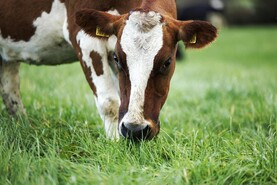Irish farmers don’t normally have a grass surplus at the end of March.
We certainly didn’t experience it last year but every year is different and 2019 is bringing its own challenges.
Grass quality
The main challenge will be to control grass quality. Too much grass at this time of year, while better than having none at all, is not good. Grass quality will suffer and when it does milk yield and protein percentage will fall, meaning a lower peak milk solids yield in April and May.
As there is no real cost associated with providing quality grass, it is a direct hit on profitability
Knocking 0.2kgMS/cow off production over the next two months will knock around 12kg of milk solids off annual production. This is worth in the region of €50 per cow depending on milk price.
As there is no real cost associated with providing quality grass, it is a direct hit on profitability.
Weather
Looking at the weather forecast, growth rates for the next 10 days should be good, between 30kg and 40kg/ha/day for most of the country on farms where there are good grass species and adequate fertiliser has been spread.
This is at demand for most farmers and when you consider that there is a lot of grass on farms anyway, it means that the herd won’t be able to eat it all.
Grass walk
The first step to controlling this should be to do a grass walk and see how much grass you have on the farm. Most have an average farm cover of 800kg to 900kg/ha which is almost double what you need currently.
Paddocks will have to be cut for silage. Lower-stocked farms can afford to close these paddocks for silage now and top them up with fertiliser for the main first cut.
Higher-stocked farmers are in more of a predicament as they will need grass back on the land with these high grass covers for grazing in April.
The best policy in this scenario is to perhaps cut some of these paddocks for bale silage now and get them back growing.
It’s difficult to get your head around it but it’s probably the best thing to do in order to avoid a grass deficit in mid-April. This really only applies to farmers with a stocking rate above 3.2 cows/ha and a grass cover in excess of 900kg/ha and growing over 40kg/day.
The advice for all farmers is to get out and walk their paddocks to assess how much grass they have and then make decisions.
Meal feeding should be at a minimum rate and silage should be out of the diet completely.
Read more
Greenfield Farm: better grazing helps March performance
Dairy management: looking after cows in early lactation
Irish farmers don’t normally have a grass surplus at the end of March.
We certainly didn’t experience it last year but every year is different and 2019 is bringing its own challenges.
Grass quality
The main challenge will be to control grass quality. Too much grass at this time of year, while better than having none at all, is not good. Grass quality will suffer and when it does milk yield and protein percentage will fall, meaning a lower peak milk solids yield in April and May.
As there is no real cost associated with providing quality grass, it is a direct hit on profitability
Knocking 0.2kgMS/cow off production over the next two months will knock around 12kg of milk solids off annual production. This is worth in the region of €50 per cow depending on milk price.
As there is no real cost associated with providing quality grass, it is a direct hit on profitability.
Weather
Looking at the weather forecast, growth rates for the next 10 days should be good, between 30kg and 40kg/ha/day for most of the country on farms where there are good grass species and adequate fertiliser has been spread.
This is at demand for most farmers and when you consider that there is a lot of grass on farms anyway, it means that the herd won’t be able to eat it all.
Grass walk
The first step to controlling this should be to do a grass walk and see how much grass you have on the farm. Most have an average farm cover of 800kg to 900kg/ha which is almost double what you need currently.
Paddocks will have to be cut for silage. Lower-stocked farms can afford to close these paddocks for silage now and top them up with fertiliser for the main first cut.
Higher-stocked farmers are in more of a predicament as they will need grass back on the land with these high grass covers for grazing in April.
The best policy in this scenario is to perhaps cut some of these paddocks for bale silage now and get them back growing.
It’s difficult to get your head around it but it’s probably the best thing to do in order to avoid a grass deficit in mid-April. This really only applies to farmers with a stocking rate above 3.2 cows/ha and a grass cover in excess of 900kg/ha and growing over 40kg/day.
The advice for all farmers is to get out and walk their paddocks to assess how much grass they have and then make decisions.
Meal feeding should be at a minimum rate and silage should be out of the diet completely.
Read more
Greenfield Farm: better grazing helps March performance
Dairy management: looking after cows in early lactation






 This is a subscriber-only article
This is a subscriber-only article










SHARING OPTIONS: